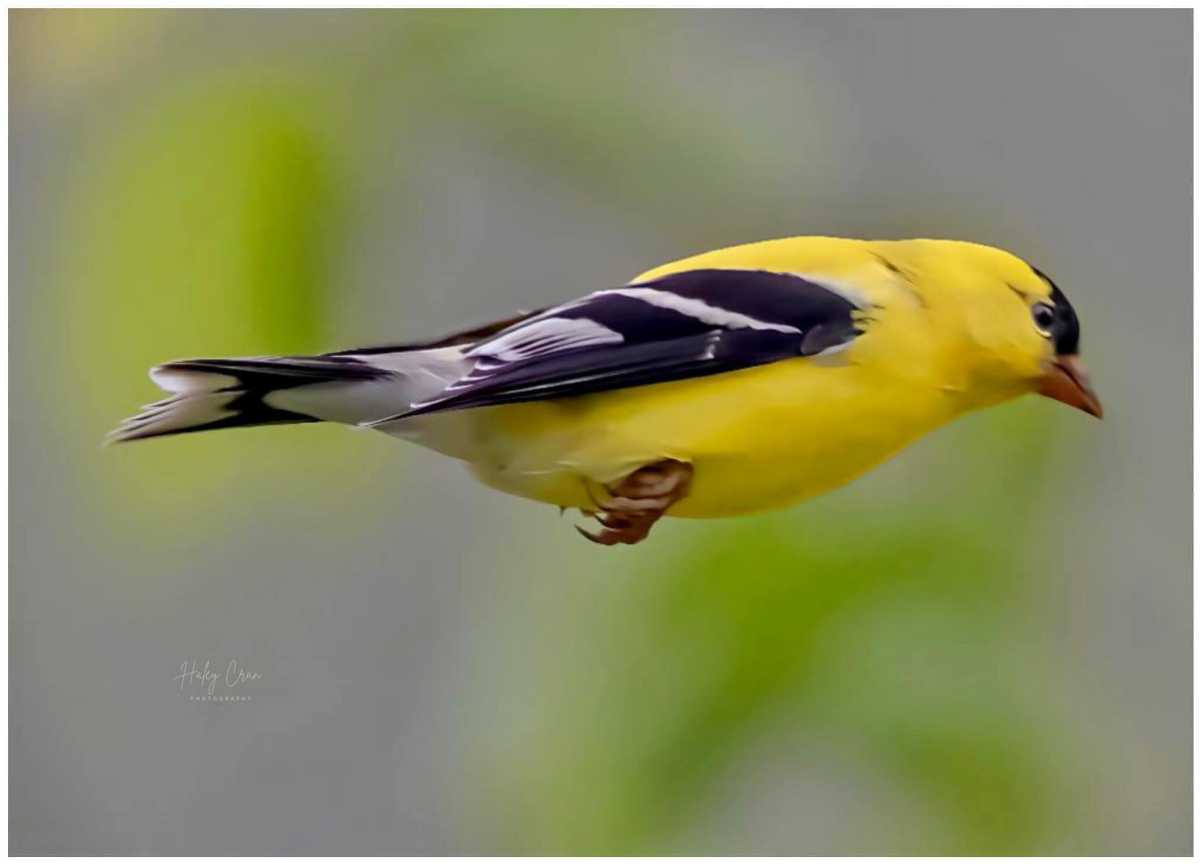Explore goldfinch migration patterns and understand when they migrate and where. Uncover the reasons behind their seasonal movements.
Key Takeaways
- American Goldfinches have variable migration patterns, with many moving based on seasonal weather changes and food availability.
- While some goldfinches migrate long distances, others might only shift a short distance south or even stay put if conditions are favorable.
- Regions like northern Virginia and southern Minnesota often retain goldfinches year-round due to milder winters and consistent food sources.
American Goldfinch Migration (When, Why, and Where)
The American goldfinch, with its unmistakable bright yellow hue, is a delight for many birdwatchers. Whether they’re playfully zipping through fields collecting seeds or making pit stops at bird feeders, they are enjoyable to look at.
If you’re like many bird enthusiasts, the American goldfinch’s movements might be unpredictable. One minute, they’re frequenting your bird feeders in Washington or New York, and the next, they’ve vanished. It’s not just your imagination; these birds have their own schedule.
Depending on your North American location, you might enjoy their company throughout the year or perhaps only for a season. It’s all part of the goldfinch migration.
Understanding Goldfinch Migration Timing
When do American Goldfinches migrate?
While some goldfinches might stay in one place, others want to migrate. This isn’t your typical bird clocking in and out on a strict schedule. Their migration is somewhat irregular; a flock might migrate this year and decide to relax the next.
For those migrating, mid-fall and early spring are peak travel times. Yet, a few might linger southwards even until early summer, way past when most birds’ travel.
When do goldfinches migrate back north?
During spring, the American goldfinch feels the call to head north. Between the months of May and June, these birds chart their course, moving to cooler terrains.
What month do goldfinches migrate south?
While most birds might decide on a specific month, goldfinches, with their characteristic unpredictability, start considering their southern visit in October, stretching it out till January.
The changing seasons, dropping temperatures, and shifts in food and water availability play a part in this decision.
Goldfinch Seasonal Locations
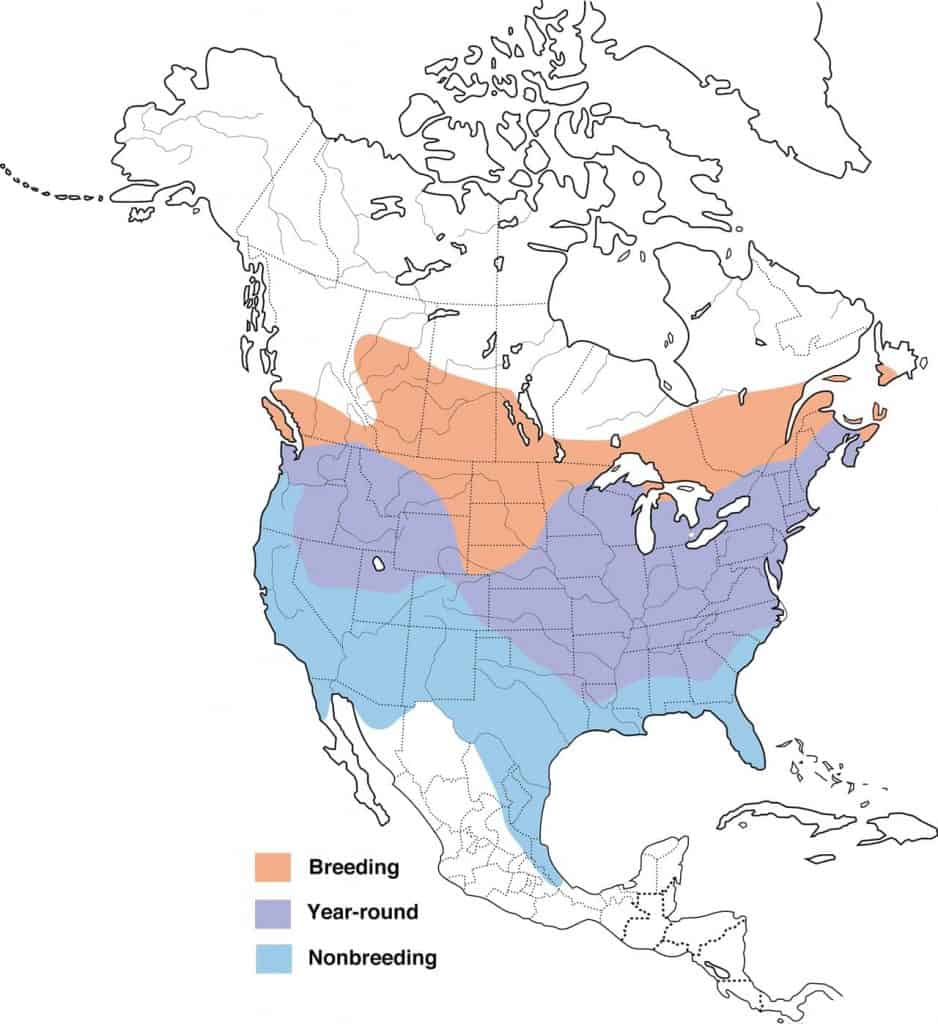
Where do American Goldfinches migrate to?
American Goldfinches have quite the travel itinerary, depending on the season. The migration destination of Goldfinches also largely depends on their breeding location.
Those that breed in the northern parts of North America, such as Canada and the northern United States migrate southward to escape the harsh winter. Their journey might take them as far south as the southern United States or even northern Mexico.
Goldfinches that breed in the central and southern parts of the U.S. might not migrate long distances, if at all.
Where do American Goldfinches go in summer?
When summer’s warmth spreads, these birds flock to the northernmost states of the U.S. like Idaho, Wyoming, and Montana. They also enjoy the northeastern charms of Connecticut, Massachusetts, New Jersey, Pennsylvania, and Rhode Island.
Venturing further, the Midwest welcomes them in states such as Illinois, Indiana, and Iowa. They even grace the Rocky Mountains’ lower elevations, particularly in Idaho, Montana, and Wyoming.
And let’s not forget about Canada: southern parts like Alberta, British Columbia, and Ontario welcome these golden visitors, as do places like New Brunswick and Nova Scotia.
Where do goldfinches go in the winter?
As winter’s chill sets in, American Goldfinches have a different game plan. In Canada, they prefer the southern coastal regions, including spots like southern British Columbia and Toronto. In the U.S., the northeast remains a favorite with states like Maine and Pennsylvania getting their fair share.
The southeast becomes a winter haven, with states from Alabama to Virginia hosting these birds. The Midwest, too, sees them in states like Illinois and Ohio. Even the Rocky Mountains region, from sparse areas in Montana to parts of Nebraska and Colorado, gets the occasional goldfinch visit.
And for those little birds craving a bit more warmth, northern Mexico, particularly areas like Ensenada and Monterrey, becomes a brief winter stop.
Goldfinch Migration Distances and Patterns
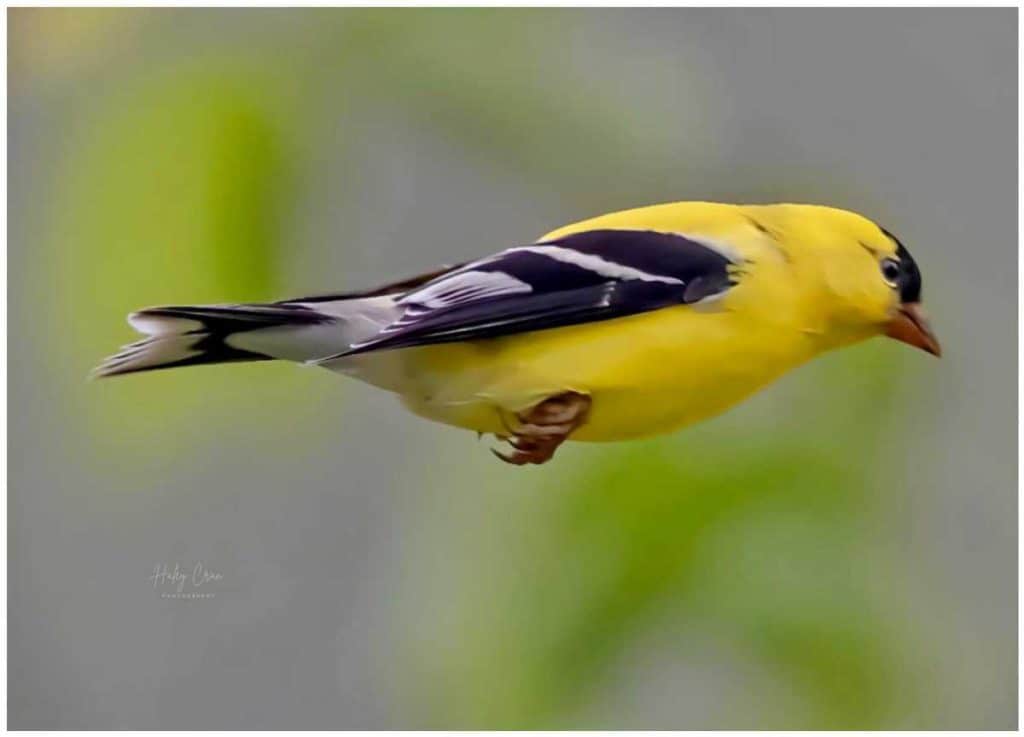
How far do American Goldfinches migrate?
The distance American Goldfinches migrate varies based on their breeding and wintering locations. On average, they can travel anywhere from a few dozen to over a thousand miles during their migration.
Goldfinches that breed in the northernmost parts of their range, such as Canada, may travel several hundred miles southward to reach milder climates in the southern U.S. or northern Mexico. Conversely, those that breed in the central or southern U.S. might migrate shorter distances or not at all.
It’s all about breeding, weather, and food availability, making each migration unique to each bird.
Goldfinch Migration Behavior
Do all American Goldfinches migrate?
No, not all American Goldfinches migrate. While it’s true many of them pack their tiny bags and leave, some are happy staying put, especially if the weather and food are just right.
For instance, female goldfinches often venture deeper south in winter compared to their male counterparts, while the young male adventurers prefer the northern chill over older males.
Why do some American Goldfinches not migrate?
Some American male and female Goldfinches do not migrate because they reside in areas where food sources, primarily seeds, remain abundant throughout the year.
Many homeowners set up bird feeders in their gardens and yards, hoping to lure the American Goldfinch to stay. This offers these birds a reason to stick around in areas they might have previously left during migration seasons.
Additionally, if the winter climate is mild, there’s less incentive for these birds to undertake the tiring journey south. In regions like the Pacific Northwest and parts of the Southeast U.S., the conditions might be suitable enough for goldfinches to remain year-round.
For example, if you take a trip to California, you’ll probably find goldfinches who’ve ditched the migratory lifestyle. Why? With pleasant weather and a steady food buffet year-round, they see no reason to leave!
Do goldfinches stay year-round?
In certain areas, yes, goldfinches stay year-round. This behavior is particularly observed where the climate is milder and food sources are consistently available.
Do goldfinches come back to the same place every year?
Many bird species, including the American Goldfinch, exhibit site fidelity, meaning they return to the same breeding grounds year after year. This behavior is advantageous as it allows them to utilize familiar territories where they know the locations of food sources, nesting sites, and potential threats.
What time of year do goldfinches molt?
American Goldfinches undergo two molts each year.
For much of the year, Goldfinches are subtly updating their look, especially gearing up for those colder months to keep a low profile against predators. But come spring and summer? It’s showtime! These birds undergo a dramatic transformation, all in the name of love.
Males, in particular, pull out all the stops with a dashing black top hat and vibrant yellow feathers, aiming to woo those discerning females. The video below shows a male goldfinch in the process of molting as he sports his bright yellow sprint feathers along with spotty remnants of the dull olive-colored ones.
Unique to the American Goldfinch, this springtime makeover is in addition to their regular end-of-breeding-season molt, setting them apart from their feathered relatives.
Regional Goldfinch Migration Queries
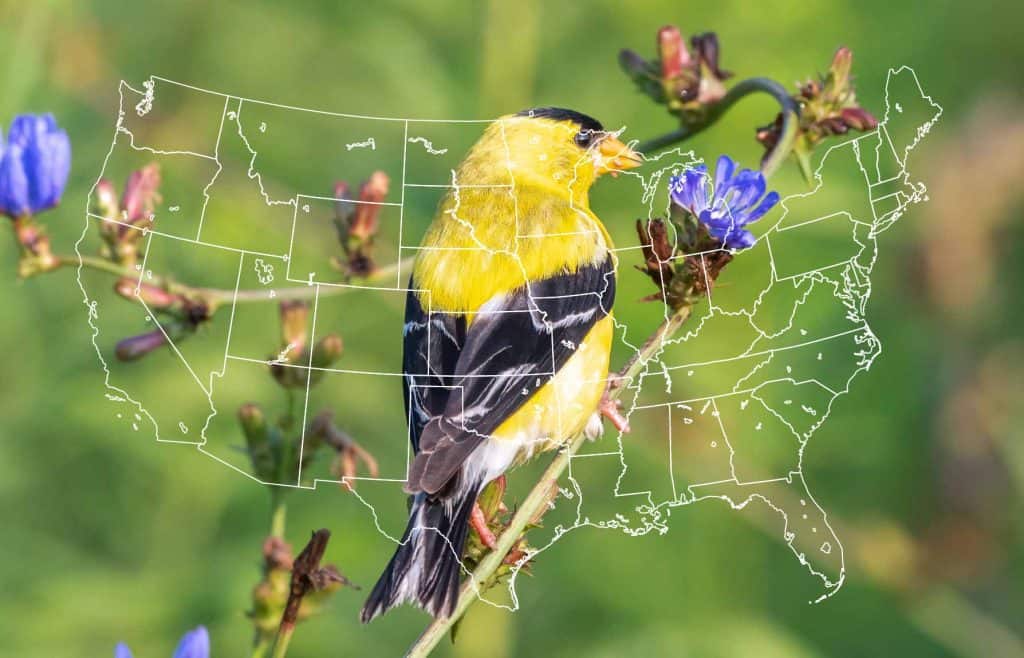
Do goldfinches migrate from Virginia?
In northern Virginia, goldfinches tend to stay put, enjoying the balance of summer and winter temperatures. But head south within the state, and you might notice a few goldfinches leaving when the summer warmth gets too hot.
Do goldfinches migrate from Minnesota?
In the northern parts, absolutely! Those chilly winter breezes have many goldfinches heading for slightly warmer locations. But they don’t always go too far. Many simply hop down to southern Minnesota, where winters are gentler and plenty of bird feeders promise feasts.
Do goldfinches migrate from Canada?
While Canada’s summer warmth might invite them over, those fierce winters with temperatures diving below zero often have goldfinches rethinking their stay. Many opt for a short trip, trading Canadian snowscapes for the milder temperatures of the northern United States.
Do goldfinches stay in the northeast in the winter?
Goldfinches can often be found in the northeastern U.S. during winter, especially if food sources and weather conditions permit. However, some might migrate to seek warmer regions or better food availability.
Do finches go south for the winter?
Yes, many goldfinches head south during winter to escape colder regions.
Goldfinch Care During Migration Seasons
Should I feed goldfinches in winter?
Yes, feeding goldfinches in winter can be beneficial for them, especially in areas where natural food sources become scarce due to snow and freezing temperatures.
Providing a consistent food source can help these birds maintain their energy levels and body condition during the challenging winter months.
If you live in an area where goldfinches are present during the winter, setting up a bird feeder can offer them much-needed support.
What do yellow finches eat in the winter?
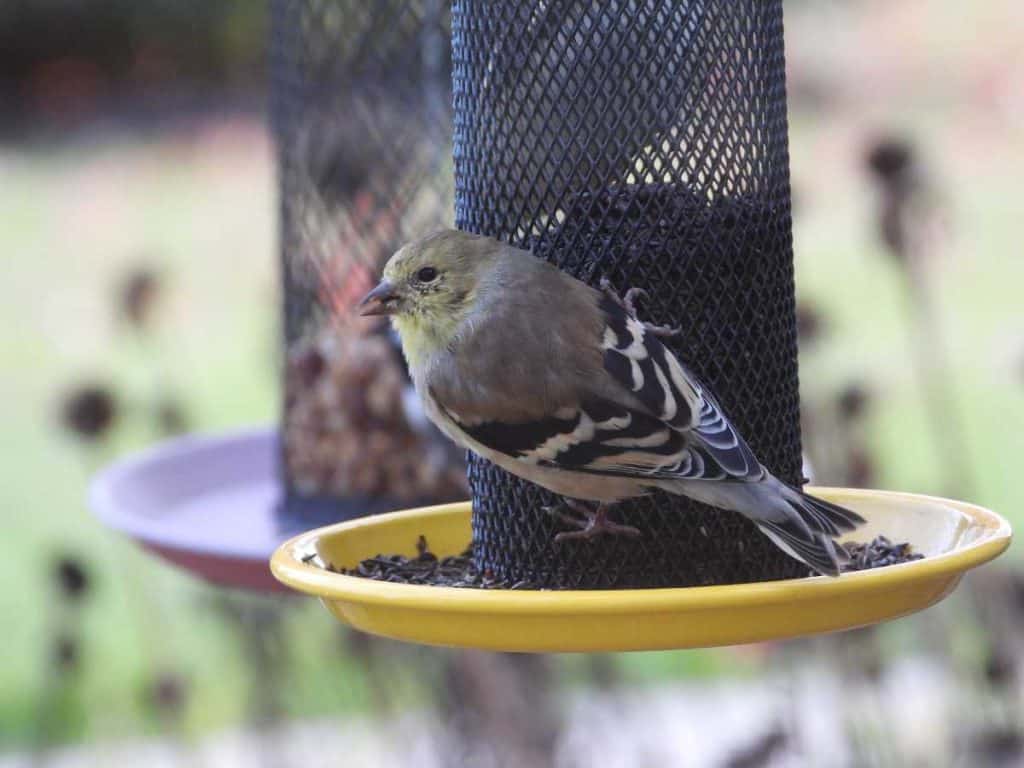
American Goldfinches primarily eat seeds throughout the year, including in the winter. A Goldfinches winter diet consists of:
- Nyjer (or Thistle) Seeds: These tiny black seeds are a staple in the goldfinch diet. Special thistle feeders, which have small holes to dispense these seeds, are often used to feed goldfinches.
- Sunflower Seeds: These are a favorite for many finches. Black oil sunflower seeds are particularly nutritious and high in fat, which provides essential energy during the cold months.
- Dandelion Seeds: Goldfinches will forage for dandelion seeds if they are available.
- Other Wild Seeds and Buds: They will also consume seeds from various wildflowers and grasses, such as asters and goldenrods.
- Tree Seeds: Occasionally, they might eat tree seeds like alder or birch seeds.
In winter, fill your feeders with Nyjer and sunflower seeds to attract goldfinches. Make sure to clean your bird feeders and have the seeds fresh to prevent the spread of diseases among the bird population.
Common Questions on Goldfinch Migration
Why have my goldfinches disappeared?
Seasonal shifts might be nudging them to migrate, either seeking warmth or returning to breeding areas.
But if they vanish during their usual stay, they might’ve found tastier food elsewhere. A single seed type or a low-quality batch could be the culprit, so mix up your birdseed with favorites like black oil sunflower, nyjer, suet, and peanuts.
Do goldfinches hibernate?
No, American Goldfinches do not hibernate.
How can I tell if goldfinches are migrating?
During migration seasons, you might notice an increase in the number of goldfinches at your feeders or see flocks of them flying in a directional pattern. Their behavior might also change; for instance, they might become more active or vocal as they prepare for their journey.
Observing their feathers can also give hints: goldfinches molt before migration, transitioning from their bright yellow summer colors to more subdued winter feathers.
Do goldfinches migrate at night?
Unlike many bird species that migrate at night, American Goldfinches are diurnal migrants, meaning they typically migrate during the day. This daytime migration allows them to feed along the way and avoid many nocturnal predators.
Do goldfinches have a set migration route?
While goldfinches have general migration patterns—moving southward in the fall and northward in the spring—the exact route can vary based on environmental conditions, food availability, and individual experiences. Over time, many birds develop preferred routes based on previous successful migrations.
Conclusion
The migration patterns of the American Goldfinch are as fascinating as they are unpredictable. Their movements, driven by changes in food availability and climate, showcase a delicate dance with nature that ensures their survival.
From the cold climates of Canada to the warm breezes of northern Mexico, these birds chart a course based on individual and environmental factors. Bird enthusiasts, in their quest to understand and appreciate these bright yellow wonders, can play a supportive role by providing food and observing their changing habits.
By understanding the intricacies of their migration, we not only gain insight into the life of the goldfinch but also the interconnectedness of nature itself. Whether they choose to migrate or stay put, one thing remains constant: the American Goldfinch’s ability to captivate and inspire all who have the privilege of witnessing their journey.

